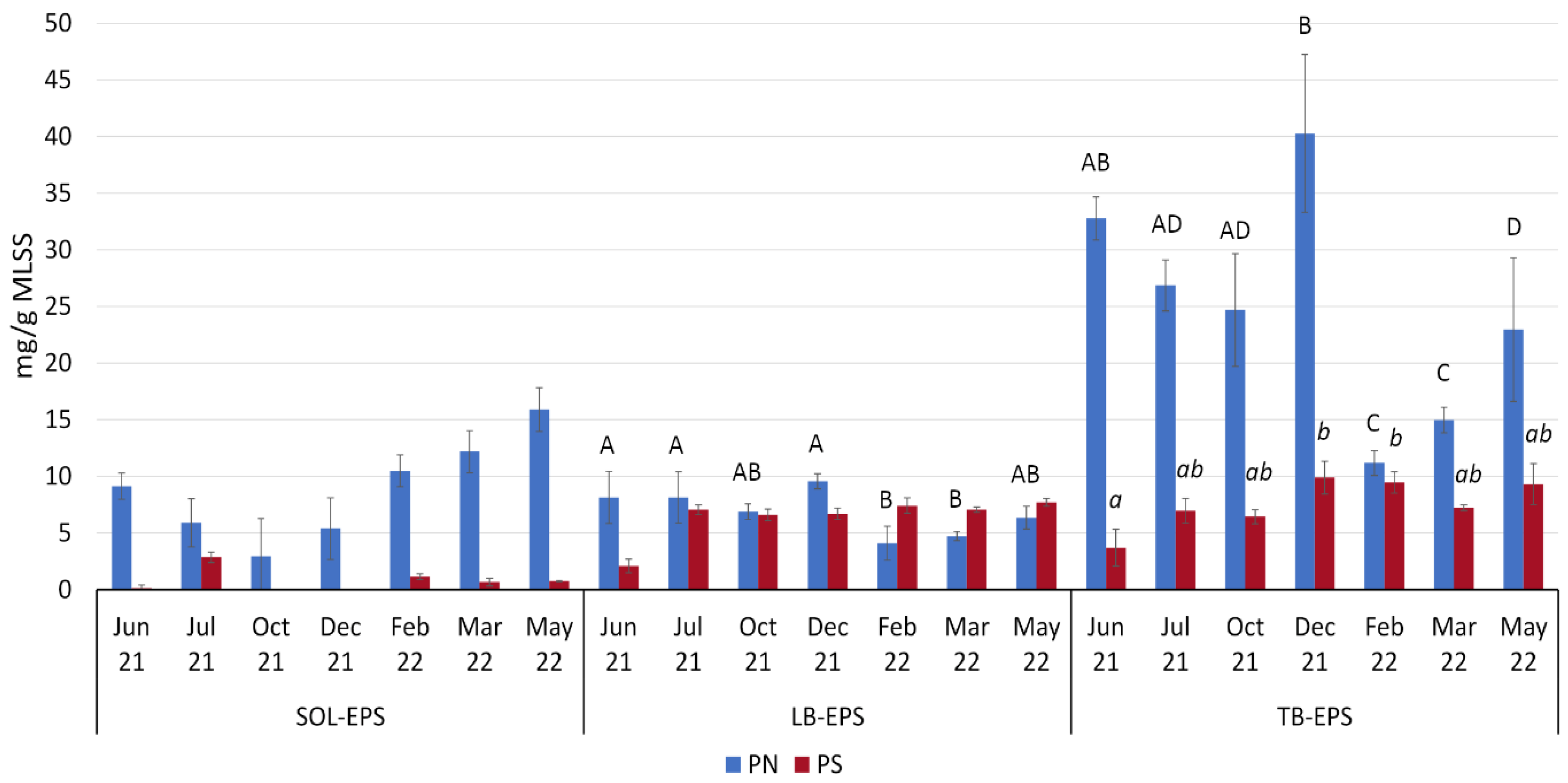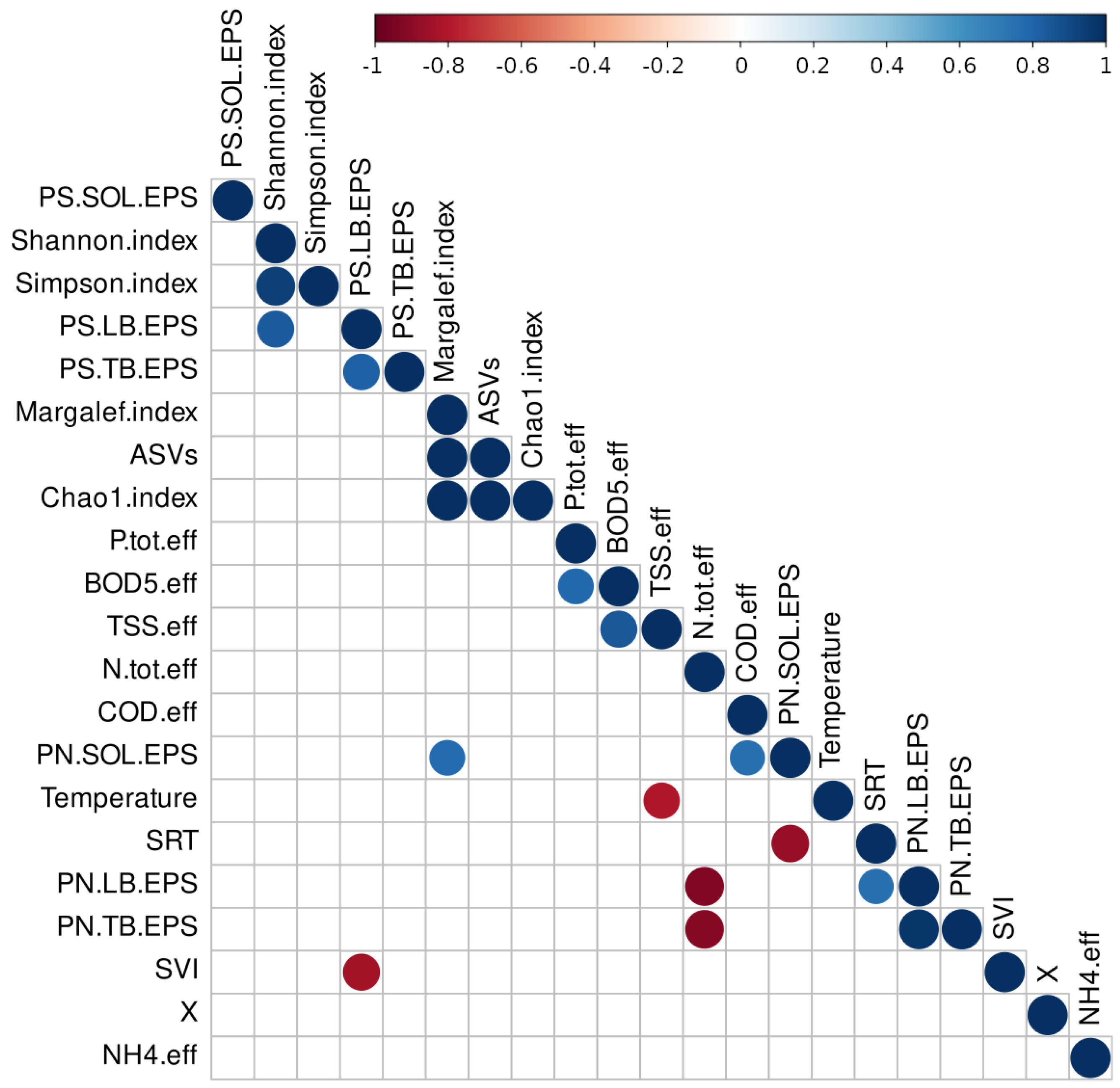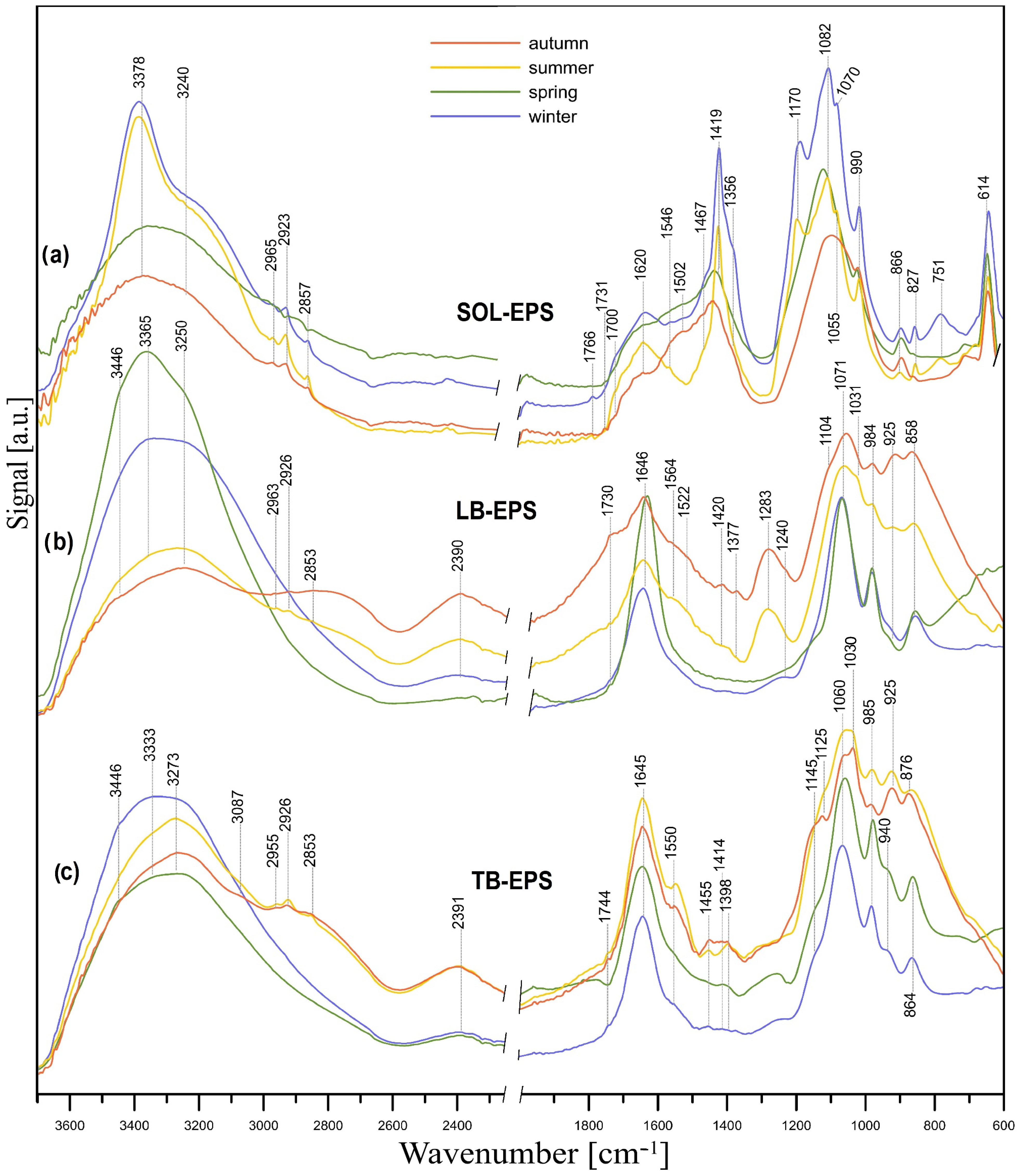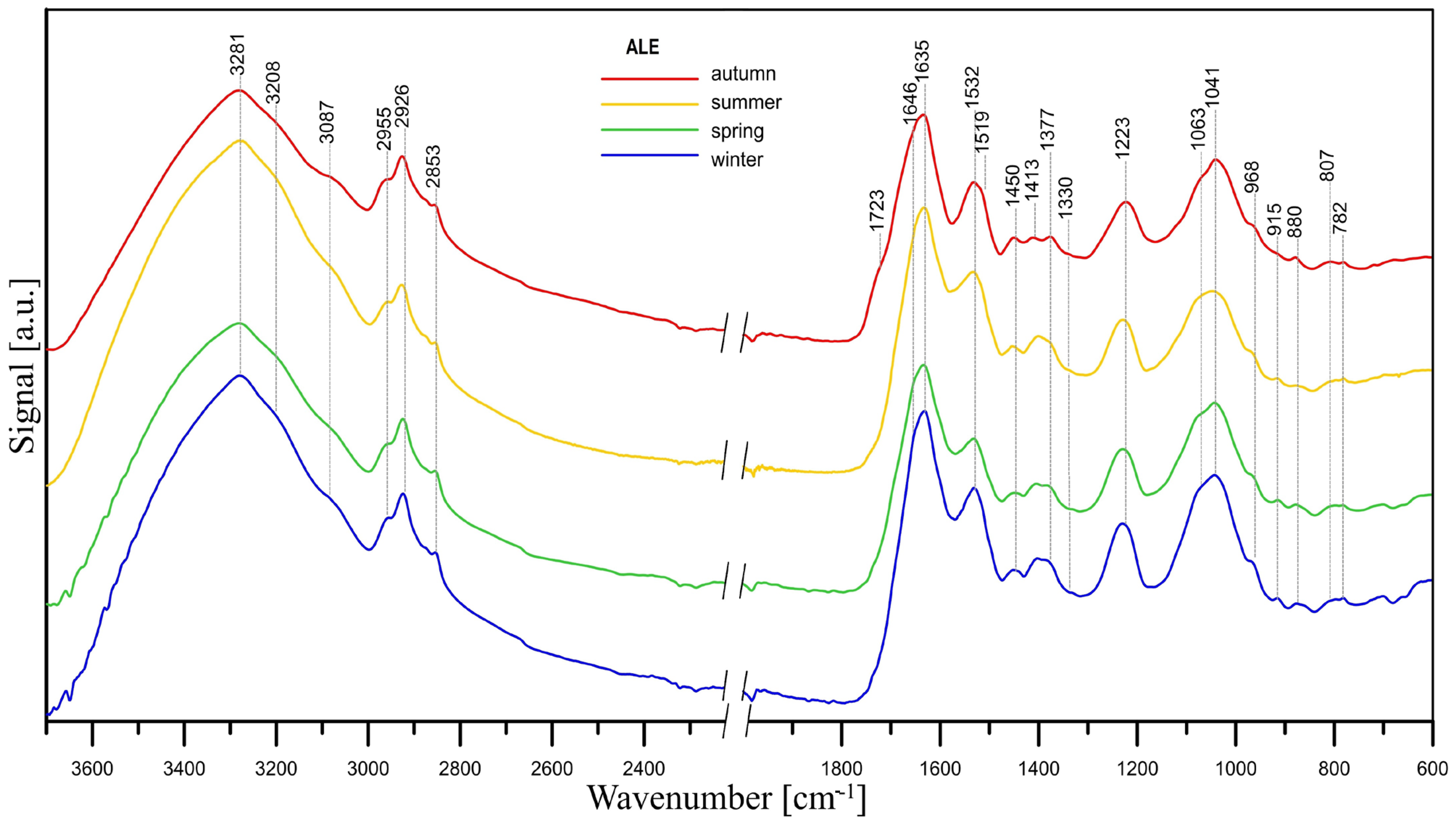Biopolymer Production in a Full-Scale Activated Sludge Wastewater Treatment Plant: Seasonal Changes and Promising Bacterial Producers
Abstract
1. Introduction
2. Materials and Methods
2.1. Sample Collection and WWTP Operation
2.2. EPS Isolation and Polymer Characteristics
2.3. Microbiological Analysis
2.4. FT-IR
2.5. Statistics
3. Results
3.1. Technological Results
3.2. Analysis of Sludge Bacterial Community
3.3. Biopolymer Characteristics
4. Conclusions
Supplementary Materials
Author Contributions
Funding
Data Availability Statement
Conflicts of Interest
References
- Schambeck, C.M.; Girbal-Neuhauser, E.; Böni, L.; Fischer, P.; Bessière, Y.; Paul, E.; da Costa, R.H.R.; Derlon, N. Chemical and Physical Properties of Alginate-like Exopolymers of Aerobic Granules and Flocs Produced from Different Wastewaters. Bioresour. Technol. 2020, 312, 123632. [Google Scholar] [CrossRef] [PubMed]
- Van Der Hoek, J.P.; De Fooij, H.; Struker, A. Wastewater as a Resource: Strategies to Recover Resources from Amsterdam’s Wastewater. Resour. Conserv. Recycl. 2016, 113, 53–64. [Google Scholar] [CrossRef]
- Adav, S.S.; Lee, D.-J. Extraction of Extracellular Polymeric Substances from Aerobic Granule with Compact Interior Structure. J. Hazard. Mater. 2008, 154, 1120–1126. [Google Scholar] [CrossRef] [PubMed]
- Rusanowska, P.; Cydzik-Kwiatkowska, A.; Świątczak, P.; Wojnowska-Baryła, I. Changes in Extracellular Polymeric Substances (EPS) Content and Composition in Aerobic Granule Size-Fractions during Reactor Cycles at Different Organic Loads. Bioresour. Technol. 2019, 272, 188–193. [Google Scholar] [CrossRef] [PubMed]
- Shen, R.; Sheng, G.-P.; Yu, H.-Q. Determination of Main Components in the Extracellular Polymeric Substances Extracted from Activated Sludge Using a Spectral Probing Method. Colloids Surf. B Biointerfaces 2012, 94, 151–156. [Google Scholar] [CrossRef]
- Cydzik-Kwiatkowska, A. Biopolymers in Aerobic Granular Sludge—Their Role in Wastewater Treatment and Possibilities of Re-Use in Line with Circular Economy. Energies 2021, 14, 7219. [Google Scholar] [CrossRef]
- Jachimowicz, P.; Jo, Y.J.; Cydzik-Kwiatkowska, A. Polyethylene Microplastics Increase Extracellular Polymeric Substances Production in Aerobic Granular Sludge. Sci. Total Environ. 2022, 851, 158208. [Google Scholar] [CrossRef]
- Rusanowska, P.; Cydzik-Kwiatkowska, A.; Wojnowska-Baryła, I. Microbial Origin of Excreted DNA in Particular Fractions of Extracellular Polymers (EPS) in Aerobic Granules. Water Air Soil. Pollut. 2019, 230, 203. [Google Scholar] [CrossRef]
- Li, X.Y.; Yang, S.F. Influence of Loosely Bound Extracellular Polymeric Substances (EPS) on the Flocculation, Sedimentation and Dewaterability of Activated Sludge. Water Res. 2007, 41, 1022–1030. [Google Scholar] [CrossRef]
- Nielsen, P.H.; Jahn, A. Extraction of EPS. In Microbial Extracellular Polymeric Substances; Springer: Berlin/Heidelberg, Germany, 1999; pp. 49–72. [Google Scholar]
- Cheng, M.; Shi, C.; Zhao, B.H.; Zhang, N.; Shen, Q.Y.; Hao, L.T.; Wang, X.Y. Recycling Alginate-like Extracellular Polymers (ALE) from Municipal Sludge: Value-Added Products and External Impact. Chem. Eng. J. 2024, 493, 152593. [Google Scholar] [CrossRef]
- Zeng, R.G.; Shi, C.; Hao, L.T.; Huang, A.; Yuan, T.; Zhang, N. A Review of Alginate-like Extracellular Polymers from Excess Sludge: Extraction, Characterization, and Potential Application. J. Water Process Eng. 2023, 56, 104346. [Google Scholar] [CrossRef]
- Chen, X.; Wang, J.; Wang, Q.; Yuan, T.; Lei, Z.; Zhang, Z.; Shimizu, K.; Lee, D.-J. Simultaneous Recovery of Phosphorus and Alginate-like Exopolysaccharides from Two Types of Aerobic Granular Sludge. Bioresour. Technol. 2022, 346, 126411. [Google Scholar] [CrossRef] [PubMed]
- Zahra, S.A.; Abdullah, N.; Iwamoto, K.; Yuzir, A.; Mohamad, S.E. Alginate-like Exopolysaccharides in Aerobic Granular Sludge: A Review. Mater. Today Proc. 2022, 65, 3046–3053. [Google Scholar] [CrossRef]
- Shahnavaz, B.; Maroof, S.; Karrabi, M.; Mashreghi, M. Characterization and Molecular Identification of Extracellular Polymeric Substance (EPS) Producing Bacteria from Activated Sludge. J. Cell Mol. Res. 2015, 7, 86–93. [Google Scholar]
- Nohua, K.; Yan, S.; Tyagi, R.D.; Surampalli, R.Y. EPS Producing Microorganisms from Municipal Wastewater Activated Sludge. J. Pet. Environ. Biotechnol. 2015, 7, 1000255. [Google Scholar]
- Cydzik-Kwiatkowska, A. Bacterial Structure of Aerobic Granules Is Determined by Aeration Mode and Nitrogen Load in the Reactor Cycle. Bioresour. Technol. 2015, 181, 312–320. [Google Scholar] [CrossRef]
- Paulo, A.M.S.; Amorim, C.L.; Costa, J.; Mesquita, D.P.; Ferreira, E.C.; Castro, P.M.L. Long-Term Stability of a Non-Adapted Aerobic Granular Sludge Process Treating Fish Canning Wastewater Associated to EPS Producers in the Core Microbiome. Sci. Total Environ. 2021, 756, 144007. [Google Scholar] [CrossRef]
- Pal, A.; Paul, A.K. Optimization of Cultural Conditions for Production of Extracellular Polymeric Substances (EPS) by Serpentine Rhizobacterium Cupriavidus pauculus KPS 201. J. Polym. 2013, 2013, 1–7. [Google Scholar] [CrossRef]
- Zisu, B.; Shah, N.P. Effects of PH, Temperature, Supplementation with Whey Protein Concentrate, and Adjunct Cultures on the Production of Exopolysaccharides by Streptococcus thermophilus 1275. J. Dairy Sci. 2003, 86, 3405–3415. [Google Scholar] [CrossRef]
- Bengoa, A.A.; Llamas, M.G.; Iraporda, C.; Dueñas, M.T.; Abraham, A.G.; Garrote, G.L. Impact of Growth Temperature on Exopolysaccharide Production and Probiotic Properties of Lactobacillus paracasei Strains Isolated from Kefir Grains. Food Microbiol. 2018, 69, 212–218. [Google Scholar] [CrossRef]
- Zeng, F.; Jin, W.; Zhao, Q. Temperature Effect on Extracellular Polymeric Substances (EPS) and Phosphorus Accumulating Organisms (PAOs) for Phosphorus Release of Anaerobic Sludge. RSC Adv. 2019, 9, 2162–2171. [Google Scholar] [CrossRef]
- Tseng, L.Y.; Gori, R.; Rosso, D. Effects of Activated Sludge Process Conditions on the Production of Extracellular Polymeric Substances: Results of Yearlong Monitoring in a Warm Climate. Environ. Eng. Sci. 2015, 32, 582–592. [Google Scholar] [CrossRef]
- Al-Halbouni, D.; Traber, J.; Lyko, S.; Wintgens, T.; Melin, T.; Tacke, D.; Janot, A.; Dott, W.; Hollender, J. Correlation of EPS Content in Activated Sludge at Different Sludge Retention Times with Membrane Fouling Phenomena. Water Res. 2008, 42, 1475–1488. [Google Scholar] [CrossRef] [PubMed]
- Cydzik-Kwiatkowska, A.; Gusiatin, M.Z.; Zielińska, M.; Wojnowska-Baryła, I.; Kulikowska, D.; Bernat, K. Alginate-like Polymers from Full-Scale Aerobic Granular Sludge: Content, Recovery, Characterization, and Application for Cadmium Adsorption. Sci. Rep. 2022, 12, 22260. [Google Scholar] [CrossRef] [PubMed]
- Lin, Y.; de Kreuk, M.; van Loosdrecht, M.C.M.; Adin, A. Characterization of Alginate-like Exopolysaccharides Isolated from Aerobic Granular Sludge in Pilot-Plant. Water Res. 2010, 44, 3355–3364. [Google Scholar] [CrossRef] [PubMed]
- van Leeuwen, K.; de Vries, E.; Koop, S.; Roest, K. The Energy & Raw Materials Factory: Role and Potential Contribution to the Circular Economy of the Netherlands. Environ. Manag. 2018, 61, 786–795. [Google Scholar] [CrossRef]
- Fan, X.-Y.; Gao, J.-F.; Pan, K.-L.; Li, D.-C.; Dai, H.-H. Temporal Dynamics of Bacterial Communities and Predicted Nitrogen Metabolism Genes in a Full-Scale Wastewater Treatment Plant. RSC Adv. 2017, 7, 56317–56327. [Google Scholar] [CrossRef]
- Liu, T.; Liu, S.; Zheng, M.; Chen, Q.; Ni, J. Performance Assessment of Full-Scale Wastewater Treatment Plants Based on Seasonal Variability of Microbial Communities via High-Throughput Sequencing. PLoS ONE 2016, 11, e0152998. [Google Scholar] [CrossRef]
- Greenberg, A.; Clesceri, L.; Eaton, A. (Eds.) Apha Standard Methods for the Examination of Water And Wastewater, 18th ed.; American Public Health Association American Water Works Association Water Environment Federation: Washington, DC, USA, 1992. [Google Scholar]
- Pellicer-Nàcher, C.; Domingo-Félez, C.; Mutlu, A.G.; Smets, B.F. Critical Assessment of Extracellular Polymeric Substances Extraction Methods from Mixed Culture Biomass. Water Res. 2013, 47, 5564–5574. [Google Scholar] [CrossRef]
- Lin, Y.M.; Wang, L.; Chi, Z.M.; Liu, X.Y. Bacterial Alginate Role in Aerobic Granular Bio-particles Formation and Settleability Improvement. Sep. Sci. Technol. 2008, 43, 1642–1652. [Google Scholar] [CrossRef]
- Leal, D.; Matsuhiro, B.; Rossi, M.; Caruso, F. FT-IR Spectra of Alginic Acid Block Fractions in Three Species of Brown Seaweeds. Carbohydr. Res. 2008, 343, 308–316. [Google Scholar] [CrossRef] [PubMed]
- Haug, A.; Larsen, B.; Smidsrød, O. Uronic Acid Sequence in Alginate from Different Sources. Carbohydr. Res. 1974, 32, 217–225. [Google Scholar] [CrossRef]
- FAO/WHO. Compendium of Food Additive Specifications. Addendum 5. (FAO Food and Nutrition Paper-52 add. 5) Joint FAO/WHO Expert Committee on Food Additives, 49th ed.; FAO: Rome, Italy, 1997. [Google Scholar]
- Florczyk, M.; Cydzik-Kwiatkowska, A.; Ziembinska-Buczynska, A.; Ciesielski, S. Comparison of Three DNA Extraction Kits for Assessment of Bacterial Diversity in Activated Sludge, Biofilm, and Anaerobic Digestate. Appl. Sci. 2022, 12, 9797. [Google Scholar] [CrossRef]
- Klindworth, A.; Pruesse, E.; Schweer, T.; Peplies, J.; Quast, C.; Horn, M.; Glöckner, F.O. Evaluation of General 16S Ribosomal RNA Gene PCR Primers for Classical and Next-Generation Sequencing-Based Diversity Studies. Nucleic Acids Res. 2013, 41, e1. [Google Scholar] [CrossRef]
- Martin, M. Cutadapt Removes Adapter Sequences from High-Throughput Sequencing Reads. EMBnet J. 2011, 17, 10. [Google Scholar] [CrossRef]
- Bolyen, E.; Rideout, J.R.; Dillon, M.R.; Bokulich, N.A.; Abnet, C.C.; Al-Ghalith, G.A.; Alexander, H.; Alm, E.J.; Arumugam, M.; Asnicar, F.; et al. Reproducible, Interactive, Scalable and Extensible Microbiome Data Science Using QIIME 2. Nat. Biotechnol. 2019, 37, 852–857. [Google Scholar] [CrossRef]
- Callahan, B.J.; McMurdie, P.J.; Rosen, M.J.; Han, A.W.; Johnson, A.J.A.; Holmes, S.P. DADA2: High-Resolution Sample Inference from Illumina Amplicon Data. Nat. Methods 2016, 13, 581–583. [Google Scholar] [CrossRef]
- Bokulich, N.A.; Kaehler, B.D.; Rideout, J.R.; Dillon, M.; Bolyen, E.; Knight, R.; Huttley, G.A.; Gregory Caporaso, J. Optimizing Taxonomic Classification of Marker-Gene Amplicon Sequences with QIIME 2’s Q2-Feature-Classifier Plugin. Microbiome 2018, 6, 90. [Google Scholar] [CrossRef]
- Quast, C.; Pruesse, E.; Yilmaz, P.; Gerken, J.; Schweer, T.; Yarza, P.; Peplies, J.; Glöckner, F.O. The SILVA Ribosomal RNA Gene Database Project: Improved Data Processing and Web-Based Tools. Nucleic Acids Res. 2012, 41, D590–D596. [Google Scholar] [CrossRef]
- Segata, N.; Izard, J.; Waldron, L.; Gevers, D.; Miropolsky, L.; Garrett, W.S.; Huttenhower, C. Metagenomic Biomarker Discovery and Explanation. Genome Biol. 2011, 12, R60. [Google Scholar] [CrossRef]
- Świątczak, P.; Cydzik-Kwiatkowska, A. Performance and Microbial Characteristics of Biomass in a Full-Scale Aerobic Granular Sludge Wastewater Treatment Plant. Environ. Sci. Pollut. Res. 2018, 25, 1655–1669. [Google Scholar] [CrossRef] [PubMed]
- Hao, X.; Li, H.; Yuan, T.; Wu, Y. Recovering and Potentially Applying of Alginate like Extracellular Polymers from Anaerobic Digested Sludge. Sci. Total Environ. 2023, 898, 165549. [Google Scholar] [CrossRef]
- Shi, C.; Zeng, R.-G.; Hao, L.-T.; Hao, X.-D.; Li, J. Extracting Compositional Blocks of Alginate-like Extracellular Polymers (ALE) from Conventional Activated Sludge (CAS). Sci. Total Environ. 2023, 867, 161371. [Google Scholar] [CrossRef] [PubMed]
- Di Martino, P. Extracellular Polymeric Substances, a Key Element in Understanding Biofilm Phenotype. AIMS Microbiol. 2018, 4, 274–288. [Google Scholar] [CrossRef]
- Guo, X.; Wang, X.; Liu, J. Composition Analysis of Fractions of Extracellular Polymeric Substances from an Activated Sludge Culture and Identification of Dominant Forces Affecting Microbial Aggregation. Sci. Rep. 2016, 6, 28391. [Google Scholar] [CrossRef] [PubMed]
- Xiong, W.; Wang, S.; Zhou, N.; Chen, Y.; Su, H. Granulation Enhancement and Microbial Community Shift of Tylosin-Tolerant Aerobic Granular Sludge on the Treatment of Tylosin Wastewater. Bioresour. Technol. 2020, 318, 124041. [Google Scholar] [CrossRef]
- Zhang, D.; Li, W.; Hou, C.; Shen, J.; Jiang, X.; Sun, X.; Li, J.; Han, W.; Wang, L.; Liu, X. Aerobic Granulation Accelerated by Biochar for the Treatment of Refractory Wastewater. Chem. Eng. J. 2017, 314, 88–97. [Google Scholar] [CrossRef]
- Ali, P.; Shah, A.A.; Hasan, F.; Hertkorn, N.; Gonsior, M.; Sajjad, W.; Chen, F. A Glacier Bacterium Produces High Yield of Cryoprotective Exopolysaccharide. Front. Microbiol. 2020, 10, 3096. [Google Scholar] [CrossRef]
- Dick, R.I.; Vesilind, P.A. The Sludge Volume Index: What Is It? J. Water Pollut. Control Fed. 1969, 41, 1285–1291. [Google Scholar]
- Jiang, F.; Qi, Y.; Shi, X. Effect of Liquid Carbon Sources on Nitrate Removal, Characteristics of Soluble Microbial Products and Microbial Community in Denitrification Biofilters. J. Clean. Prod. 2022, 339, 130776. [Google Scholar] [CrossRef]
- Wang, X.; Chen, T.; Gao, C.; Xie, Y.; Zhang, A. Effect of Extracellular Polymeric Substances Removal and Re-Addition on the Denitrification Performance of Activated Sludge: Carbon Source Metabolism, Electron Transfer and Enzyme Activity. J. Environ. Chem. Eng. 2022, 10, 108069. [Google Scholar] [CrossRef]
- Bomfeti, C.A.; Florentino, L.A.; Guimarães, A.P.; Cardoso, P.G.; Guerreiro, M.C.; Moreira, F.M.d.S. Exopolysaccharides Produced by the Symbiotic Nitrogen-Fixing Bacteria of Leguminosae. Rev. Bras. Ciênc. Solo 2011, 35, 657–671. [Google Scholar] [CrossRef]
- Liu, J.; Liang, X.; Yang, C.; Yu, S.; Guo, H. Tracing Membrane Biofouling to the Microbial Community Structure and Its Metabolic Products: An Investigation on the Three-Stage MBR Combined with Worm Reactor Process. Bioresour. Technol. 2019, 278, 165–174. [Google Scholar] [CrossRef] [PubMed]
- Nguyen, T.T.H.; Vuong, T.Q.; Han, H.L.; Li, Z.; Lee, Y.-J.; Ko, J.; Nedashkovskaya, O.I.; Kim, S.-G. Three Marine Species of the Genus Fulvivirga, Rich Sources of Carbohydrate-Active Enzymes Degrading Alginate, Chitin, Laminarin, Starch, and Xylan. Sci. Rep. 2023, 13, 6301. [Google Scholar] [CrossRef] [PubMed]
- Li, W.-M.; Liao, X.-W.; Guo, J.-S.; Zhang, Y.-X.; Chen, Y.-P.; Fang, F.; Yan, P. New Insights into Filamentous Sludge Bulking: The Potential Role of Extracellular Polymeric Substances in Sludge Bulking in the Activated Sludge Process. Chemosphere 2020, 248, 126012. [Google Scholar] [CrossRef] [PubMed]
- Guimarães, L.B.; Gubser, N.R.; Lin, Y.; Zlópasa, J.; Felz, S.; Tomás Martínez, S.; Weissbrodt, D.G. Production of Extracellular Polymeric Substances in Granular Sludge under Selection for Accumulibacter and Competibacter. bioRxiv 2023, 1–45. [Google Scholar]
- Gupta, R.S.; Chander, P.; George, S. Phylogenetic Framework and Molecular Signatures for the Class Chloroflexi and Its Different Clades; Proposal for Division of the Class Chloroflexi Class. Nov. into the Suborder Chloroflexineae Subord. Nov., Consisting of the Emended Family Oscillochloridaceae and the Family Chloroflexaceae Fam. Nov., and the Suborder Roseiflexineae Subord. Nov., Containing the Family Roseiflexaceae Fam. Nov. Antonie Leeuwenhoek 2013, 103, 99–119. [Google Scholar] [CrossRef]
- Bernardet, J.-F.; Bowman, J.P. The Genus Flavobacterium. In The Prokaryotes; Springer: New York, NY, USA, 2006; pp. 481–531. [Google Scholar]
- Pikuta, E.V.; Hoover, R.B. The Genus Trichococcus. In Lactic Acid Bacteria; Wiley: Hoboken, NJ, USA, 2014; pp. 135–145. [Google Scholar]
- Strepis, N.; Naranjo, H.D.; Meier-Kolthoff, J.; Göker, M.; Shapiro, N.; Kyrpides, N.; Klenk, H.-P.; Schaap, P.J.; Stams, A.J.M.; Sousa, D.Z. Genome-Guided Analysis Allows the Identification of Novel Physiological Traits in Trichococcus Species. BMC Genom. 2020, 21, 24. [Google Scholar] [CrossRef]
- Zhu, X.; Lee, L.W.; Song, G.; Zhang, X.; Gao, Y.; Yang, G.; Luo, S.; Huang, X. Deciphering Mono/Multivalent Draw Solute-Induced Microbial Ecology and Membrane Fouling in Anaerobic Osmotic Membrane Bioreactor. Water Res. 2022, 209, 117869. [Google Scholar] [CrossRef]
- Shao, Y.; Zhang, H.; Buchanan, I.; Mohammed, A.; Liu, Y. Comparison of Extracellular Polymeric Substance (EPS) in Nitrification and Nitritation Bioreactors. Int. Biodeterior. Biodegrad. 2019, 143, 104713. [Google Scholar] [CrossRef]
- Socrates, G. Infrared and Raman Characteristic Group Frequencies: Tables and Charts, 3rd ed.; John Wiley&Sons, Ltd.: Chichester, UK, 2004. [Google Scholar]
- Ciempiel, W.; Czemierska, M.; Szymańska-Chargot, M.; Zdunek, A.; Wiącek, D.; Jarosz-Wilkołazka, A.; Krzemińska, I. Soluble Extracellular Polymeric Substances Produced by Parachlorella kessleri and Chlorella vulgaris: Biochemical Characterization and Assessment of Their Cadmium and Lead Sorption Abilities. Molecules 2022, 27, 7153. [Google Scholar] [CrossRef] [PubMed]
- Ramesh, A.; Lee, D.-J.; Hong, S.G. Soluble microbial products (SMP) and soluble extracellular polymeric substances (EPS) from wastewater sludge. Appl. Microbiol. Biotechnol. 2006, 73, 219–225. [Google Scholar] [CrossRef] [PubMed]
- Ami, D.; Lavatelli, F.; Rognoni, P.; Palladini, G.; Raimondi, S.; Giorgetti, S.; Monti, L.; Doglia, S.M.; Natalello, A.; Merlini, G. In situ characterization of protein aggregates in human tissues affected by light chain amyloidosis: A FTIR microspectroscopy study. Sci. Rep. 2016, 6, 29096. [Google Scholar] [CrossRef]
- Liang, Z.; Li, W.; Yang, S.; Du, P. Extraction and structural characteristics of extracellular polymeric substances (EPS), pellets in autotrophic nitrifying biofilm and activated sludge. Chemosphere 2010, 81, 626–632. [Google Scholar] [CrossRef] [PubMed]
- Sakugawa, K.; Ikeda, A.; Takemura, A.; Ono, H. Simplified Method for Estimation of Composition of Alginates by FTIR. J. Appl. Polym. Sci. 2004, 93, 1372–1377. [Google Scholar] [CrossRef]
- Sam, S.B.; Dulekgurgen, E. Characterization of exopolysaccharides from floccular and aerobic granular activated sludge as alginate-like-exoPS. Desalination Water Treat. 2016, 57, 2534–2545. [Google Scholar] [CrossRef]
- Oliveira, A.S.; Amorim, C.L.; Ramos, M.A.; Mesquita, D.P.; Inocêncio, P.; Ferreira, E.C.; Van Loosdrecht, M.; Castro, P.M. Variability in the composition of extracellular polymeric substances from a full-scale aerobic granular sludge reactor treating urban wastewater. J. Environ. Chem. Eng. 2020, 8, 104156. [Google Scholar] [CrossRef]
- Breitenbach, R.; Silbernagl, D.; Toepel, J.; Sturm, H.; Broughton, W.J.; Sassaki, G.L.; Gorbushina, A.A. Corrosive extracellular polysaccharides of the rock-inhabiting model fungus Knufia petricola. Extremophiles 2018, 22, 165–175. [Google Scholar] [CrossRef] [PubMed]
- Mecozzi, M.; Pietrantonio, E. Carbohydrates proteins and lipids in fulvic and humic acids of sediments and its relationships with mucilaginous aggregates in the Italian seas. Mar. Chem. 2006, 101, 27–39. [Google Scholar] [CrossRef]
- Daemi, H.; Barikani, M. Synthesis and characterization of calcium alginate nanoparticles, sodium homopolymannuronate salt and its calcium nanoparticles. Sci. Iran. 2012, 19, 2023–2028. [Google Scholar] [CrossRef]
- Liu, W.; Zhang, J.; Jin, Y.; Zhao, X.; Cai, Z. Adsorption of Pb(II), Cd(II) and Zn(II) by extracellular polymeric substances extracted from aerobic granular sludge: Efficiency of protein. J. Environ. Chem. Eng. 2015, 3, 1223–1232. [Google Scholar] [CrossRef]
- Kavita, K.; Mishra, A.; Jha, B. Isolation and physico-chemical characterisation of extracellular polymeric substances produced by the marine bacterium Vibrio parahaemolyticus. Biofouling 2011, 27, 309–317. [Google Scholar] [CrossRef] [PubMed]
- Clarke, A.D.; Huang, H.; Grün, I.U.; Ellersieck, M. Measurement of Total Sodium Alginate in Restructured Fish Products Using Fourier Transform Infrared Spectroscopy. EC Nutr. 2017, 11, 33–45. [Google Scholar]
- Belattmania, Z.; Kaidi, S.; El Atouani, S.; Katif, C.; Bentiss, F.; Jama, C.; Reani, A.; Sabour, B.; Vasconcelos, V. Isolation and FTIR-ATR and 1H NMR Characterization of Alginates from the Main Alginophyte Species of the Atlantic Coast of Morocco. Molecules 2020, 25, 4335. [Google Scholar] [CrossRef] [PubMed]
- Fenoradosoa, T.A.; Ali, G.; Delattre, C.; Laroche, C.; Petit, E.; Wadouachi, A.; Michaud, P. Extraction and characterization of an alginate from the brown seaweed Sargassum turbinarioides Grunow. J. Appl. Phycol. 2010, 22, 131–137. [Google Scholar] [CrossRef]
- Abka-khajouei, R.; Tounsi, L.; Shahabi, N.; Patel, A.K.; Abdelkafi, S.; Michaud, P. Structures, Properties and Applications of Alginates. Mar. Drugs 2022, 20, 364. [Google Scholar] [CrossRef]
- Zhang, H.; Cheng, J.; Ao, Q. Preparation of Alginate-Based Biomaterials and Their Applications in Biomedicine. Mar. Drugs 2021, 19, 264. [Google Scholar] [CrossRef]
- Lin, Y.M.; Sharma, P.K.; van Loosdrecht, M.C.M. The Chemical and Mechanical Differences between Alginate-like Exopolysaccharides Isolated from Aerobic Flocculent Sludge and Aerobic Granular Sludge. Water Res. 2013, 47, 57–65. [Google Scholar] [CrossRef]
- Hurtado, A.; Aljabali, A.A.A.; Mishra, V.; Tambuwala, M.M.; Serrano-Aroca, Á. Alginate: Enhancement Strategies for Advanced Applications. Int. J. Mol. Sci. 2022, 23, 4486. [Google Scholar] [CrossRef]
- Shi, C.; Zeng, R.-G.; Yuan, S.-C.; Zhang, L.; Wang, X.-Y.; Hao, L.-T.; Hao, X.-D.; Zhang, N.; Wu, Y.-Y. Preparing a Heavy-Metal Adsorbent Based on Alginate-like Extracellular Polymers from Conventional Activated Sludge via Polyethyleneimine Grafting. Sustain. Chem. Pharm. 2024, 38, 101472. [Google Scholar] [CrossRef]







Disclaimer/Publisher’s Note: The statements, opinions and data contained in all publications are solely those of the individual author(s) and contributor(s) and not of MDPI and/or the editor(s). MDPI and/or the editor(s) disclaim responsibility for any injury to people or property resulting from any ideas, methods, instructions or products referred to in the content. |
© 2024 by the authors. Licensee MDPI, Basel, Switzerland. This article is an open access article distributed under the terms and conditions of the Creative Commons Attribution (CC BY) license (https://creativecommons.org/licenses/by/4.0/).
Share and Cite
Cydzik-Kwiatkowska, A.; Ciesielski, S.; Florczyk, M.; Pasieczna-Patkowska, S.; Komorowska-Kaufman, M.; Pomian, W.; Jóźwiak, K.; Oleskowicz-Popiel, P. Biopolymer Production in a Full-Scale Activated Sludge Wastewater Treatment Plant: Seasonal Changes and Promising Bacterial Producers. Energies 2024, 17, 6231. https://doi.org/10.3390/en17246231
Cydzik-Kwiatkowska A, Ciesielski S, Florczyk M, Pasieczna-Patkowska S, Komorowska-Kaufman M, Pomian W, Jóźwiak K, Oleskowicz-Popiel P. Biopolymer Production in a Full-Scale Activated Sludge Wastewater Treatment Plant: Seasonal Changes and Promising Bacterial Producers. Energies. 2024; 17(24):6231. https://doi.org/10.3390/en17246231
Chicago/Turabian StyleCydzik-Kwiatkowska, Agnieszka, Sławomir Ciesielski, Maciej Florczyk, Sylwia Pasieczna-Patkowska, Małgorzata Komorowska-Kaufman, Weronika Pomian, Kinga Jóźwiak, and Piotr Oleskowicz-Popiel. 2024. "Biopolymer Production in a Full-Scale Activated Sludge Wastewater Treatment Plant: Seasonal Changes and Promising Bacterial Producers" Energies 17, no. 24: 6231. https://doi.org/10.3390/en17246231
APA StyleCydzik-Kwiatkowska, A., Ciesielski, S., Florczyk, M., Pasieczna-Patkowska, S., Komorowska-Kaufman, M., Pomian, W., Jóźwiak, K., & Oleskowicz-Popiel, P. (2024). Biopolymer Production in a Full-Scale Activated Sludge Wastewater Treatment Plant: Seasonal Changes and Promising Bacterial Producers. Energies, 17(24), 6231. https://doi.org/10.3390/en17246231








